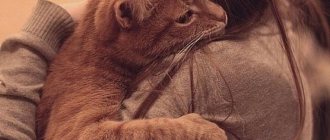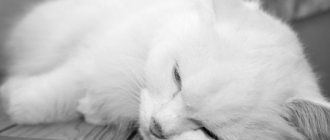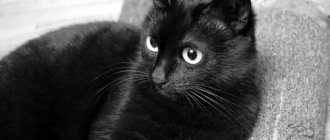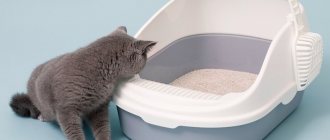The natural stages of life - birth and death - are always nearby. This applies to any living beings inhabiting the Planet. Pets are no exception, and one day a cat owner inevitably faces the death of a pet. Anyone who has an animal at home should know how to understand that a cat is dying and how to help it alleviate its suffering. In some cases, due to incurable and dangerous diseases that cause severe suffering to the cat, it is prudent to carry out euthanasia.
Causes of death of cats
The lifespan of pets is much shorter than humans. There are not many causes of death for cats:
- natural – death from old age;
- from illness;
- sudden death as a result of an accident.
You can prepare for the first two reasons and alleviate the suffering of your pet. The sudden death of a cat occurs suddenly; it is impossible to know about it in advance. It is experienced much more acutely than the death of an animal due to natural causes.
From old age
On average, domestic cats live 12–15 years. Cats die of old age at 10–11 years of age, but they can live much longer and die at the age of 20. It all depends on the breed and individual characteristics of the animal.
Interesting! Outbred cats live especially long, since their genetic apparatus has not been damaged by inbreeding.
If the cat's age has passed the 13-year mark and he becomes less active and sleeps a lot, we can conclude that his life's journey is coming to an end. By human standards, this is almost 70 years of age.
Each subsequent year of life is plus 7 years. An animal dying of old age does not experience pain: it gradually loses its vitality and fades away.
If a cat dies at home, a caring owner should provide her with peace and good care.
From illness
Diseases that threaten the life of a cat:
- Infections. They take first place among the reasons from which an unvaccinated kitten can die. Free-ranging cats are also at risk. An animal can also become infected during a planned mating if the partner is sick. The owners may not be aware of this circumstance if the disease occurs in a latent (hidden) form.
- Kidney failure is a consequence of castration and sterilization and significantly shortens the life of cats. The disease is treatable if noticed in time. In its advanced form, it will lead to the death of the cat.
- Oncology. Unfortunately, animals also often die from cancer. The risk of this disease is especially high in adult cats, but cancer is increasingly being diagnosed in young cats.
Cat mysticism
Cats are known to be natural psychics. They heal, predict weather and earthquakes, and discover new abilities in people. Great importance is also attached to how the cat passed away. It’s one thing if death occurred due to natural causes: old age, illness, accident. And it’s a completely different matter when a cat died suddenly, for no apparent reason. People prone to mysticism see here witchcraft, corruption, overwhelming human emotions and the influence of otherworldly forces.
Since ancient times, cats have been attributed magical properties.
It has been known since ancient times that cats do not die where they live. Anticipating their death, they try to hide away from prying eyes, closer to the other world. Neither scientists nor astrologers can explain this fact.
Signs that a cat is dying
You can understand that a cat is dying by certain signs long before this sad event. Changes in behavior and appearance will tell the owners of a dying cat that its departure is inevitable.
Lack of appetite
One of the signs of illness or imminent death is loss of appetite. The cat first loses interest in food, eats without pleasure, and then stops eating altogether. Refusal of water for several days is a signal that the cat is dying.
The following symptoms should also raise alarm:
- an empty litter tray is evidence of a failure of the gastrointestinal tract;
- black bowel movements and vomiting indicate internal bleeding;
- dark urine - the kidneys cannot cope with filtration.
The consequences of an eating disorder will not keep you waiting - restoration of the body will be impossible.
Labored breathing
The accumulation of fluid in the lungs is a consequence of metabolic disorders and kidney failure. Breathing becomes frequent and shallow. Even with minor physical exertion, the cat develops shortness of breath.
Slow heart rate
Due to a malfunction of the excretory system and dehydration, the blood thickens. The heart has difficulty pumping it through the vessels that have lost their tone and begins to malfunction. The pressure drops and the heart rate decreases.
The normal heart rate of a healthy cat is 120–140 beats per minute. In a dying animal it will be uneven and weak. To determine the heart rate, you need to place your palm under the cat's left paw.
Specific smell
The cat's body weakens before death, waste and toxins are not eliminated through the intestines and urinary system. Metabolic products are released along with sweat, exhaled air, through the mucous membranes. An unpleasant odor begins to emanate from the cat. The appearance of this sign indicates that the pet will die soon.
Reduced temperature
Body temperature drops due to the decline of vital functions. Normally, the thermometer readings should not be lower than 37.7°C. If this value gradually becomes lower, the cat dies.
Important! This sign of imminent death can be determined without a thermometer. You need to touch the paw pads of the animal: they are cold on a dying cat.
Complications leading to the death of a kitten
Kittens that have suffered birth trauma or intrauterine infection are at risk. Low weight and a weakened body will not allow such a baby to withstand competition with its brothers in the fight for mother's milk.
The respiratory processes of a sick cat are inhibited, the sucking reflex is weak, the body temperature drops below normal, the functioning of the circulatory system slows down, and then motor activity is lost. These processes irreversibly lead to convulsions, coma and death.
Dehydration
A kitten's kidneys are underdeveloped (compared to an adult animal) and excrete a large amount of fluid. Therefore, the body of a cat baby needs a constant supply of moisture. If the baby eats sluggishly or shows symptoms of diarrhea, this is a harbinger of impending dehydration. Weight loss is caused by fluid loss. Other signs of dehydration:
- dry mouth;
- bright pink color of the tongue and mucous membrane;
- flabby body muscles;
- drop in physical activity.
Symptoms of dehydration indicate the need to provide additional nutrition for the baby. Your veterinarian may recommend saline injections.
Hemolysis
Hemolysis is a disease caused by an unfortunate combination of the blood types of the father and mother of the cub. From the moment of birth, the kitten’s body begins to destroy foreign red blood cells. Antibodies that enter the bloodstream with mother's milk are responsible for this protective process.
Each blood group (A, B or AB) has its own type of antibodies. At the same time, antibodies of group B are hostile (bind) to red blood cells of group A. If the baby has inherited the paternal blood group A or AB, then the antibodies obtained with mother's milk (type B blood) will lead to the destruction of red blood cells, the development of anemia and complete metabolic disorders in the body.
The process of breakdown of red blood cells is especially active in the first days after birth. As a measure to protect babies at risk, they are bottle-fed formula for the first 16 hours. After this time, the walls of the baby’s intestines become stronger and stop allowing antibodies into the blood. The negative consequences of such precautions are due to the fact that in the first hours the baby’s body receives globulins, which are responsible for the state of the body’s immune system.
If it is not possible to determine the baby’s blood type, you can look at the color of the baby’s urine after the first reduced intake of mother’s milk. A brown tint will indicate problems with antibodies. To minimize the risk of hemolysis, breeders adhere to the following rules: cats with blood type B can be crossed with any partners, cats with blood type A can be bred with any cats. Cats with type A are only allowed to mate with animals of the same blood group.
Conjunctivitis
Kittens' eyelids remain closed until ten days after birth. If there are minor injuries, pathogenic bacteria and viruses can enter the sinus between the eyelid and the eye. If the eyelids are swollen and red, and purulent discharge flows from the eye, there is a reason to consult a veterinarian. Among the causes of such symptoms may be intrauterine infection with viral herpes.
Usually the disease affects several babies at once. To treat the eyelids, you need to peel them apart, wash your eyes with a two percent solution of boric acid and take a course of antibiotic treatment (in drops).
Brits crawl into a ball to stay warm
Stages of death
Death is not an instant, but a process that gradually turns off the body, passing it through the following stages:
- Preagonia - loss of consciousness, cessation of blood circulation, pallor and cyanosis of the skin. This stage can last from several minutes to an hour.
- Terminal pause (preagonia). Breathing practically stops, pressure drops to zero. The oculomotor reflex disappears.
- Agony. Characterized by a lack of consciousness and tactile sensitivity. Breathing may resume and blood pressure may rise. Convulsions may occur.
- Clinical death. Complete stop of all vital processes. When carrying out resuscitation measures, it is possible to “start up” the cat’s body. The duration of the period is about 8 minutes.
- Biological death. This stage is irreversible and is characterized by the complete cessation of all physiological processes in the cat.
Behavior of cats before death
Before death, cats behave strangely, and it is impossible not to notice.
Cats leave home to die elsewhere. If the pet is free-range, then it has this opportunity. Many owners say that before leaving, an elderly or sick cat would cuddle and purr in a special way.
It is not difficult to track signs of imminent death if a cat dies of old age or a long-term illness and is in an apartment with its owners:
- Eating disorder. The cat seems to forget why it comes to the feeding place. She can sit near a bowl of food or water for a long time and never touch it.
- Loss of control over physiological functions. An older cat suddenly begins to empty his bowels and bladder outside the litter box.
- The cat constantly changes its resting place: it can lie down in a passable place or hide in dark, cramped corners.
- Disorder of the cat's motor functions: unsteadiness of gait, aimless walking around the house, loss of coordination.
- Constant meowing. This is how the cat tries to attract the owner’s attention and asks him to help.
- The pet stops performing “cat litter” - licking itself.
- The cat sleeps a lot.
Sunken eyes, dull fur, sudden weight loss, lethargy and apathy should alert the owner. A veterinarian's examination and palliative treatment will help prolong the cat's life if it is seriously ill.
Is it humane to euthanize a pet?
The question of the necessity and humanity of euthanasia in relation to a dying cat is decided by its owner. It is very difficult to decide to euthanize your pet, almost a family member.
The arguments for resolving this problem are:
- incurability of the disease;
- the suffering the animal experiences;
- the inevitability of painful death.
Euthanasia will help reduce the time of agony and make the process of leaving the cat quick and painless.
You can refuse this procedure in favor of taking strong painkillers. In this case, the cat will not feel pain, but will remain unconscious until the very end.
In modern veterinary clinics, animals are euthanized for health reasons and with the consent of the owner. First, the cat is given anesthesia and falls asleep. Then a drug is injected that stops breathing and heart function.
Hosts' actions
The owner’s task is to provide the pet with comfortable conditions and alleviate suffering:
- Equipment for a warm, comfortable bed.
- Organizing a tray next to an exhausted pet.
- Free access to water.
- Ensuring peace (if touching causes discomfort in the patient, it is better not to touch her).
- Administration of painkillers (if the cause of death is a disease that causes severe pain).
Veterinarian help
The warning signs of a cat's death are very similar to the symptoms of reversible diseases. If you show the animal to a doctor in time, he will help determine the severity of its condition and select effective treatment. If the pet does die, the veterinarian will be able to understand why.
When a pet experiences unbearable pain, the doctor will offer the owner the service of euthanasia. Such a decision will free her from torment. The owner has the right to decide how his suffering pet will go.
What to do after the death of an animal
Despite the pain of loss, the owner of the deceased cat has urgent matters to complete. If a cat dies on the street or at home, you need to bury it yourself. This can be done on your own property, in the forest or in an animal cemetery.
Cats that die in veterinary hospitals are buried by special services. The owner pays for the service, says goodbye to the pet and leaves the body in the hospital.
Mr. Cat explains: funeral
After death, the animal’s body must be buried with dignity and, importantly, correctly. Many veterinary clinics offer pet cremation services, however, in the event that the animal died in the hospital or was euthanized there.
For those who have passed into another world at home, special pet cemeteries provide their services. They are in large cities. A place for a grave or an urn with ashes is provided for a fee. There, owners can set up a place in memory of their pet and visit him.
Most people prefer to bury their dead cats themselves. This is not recommended by sanitary and epidemiological standards, but is practiced everywhere.
There are a number of rules that will help you comply with environmental and ethical standards when burying remains:
- It is better to choose a part of the park that is deserted and far from walking trails and other animals. You can make a grave in the forest. Sometimes pets are buried with relatives in a human cemetery. You need to know that burying animals on the owner’s personal property is not prohibited, but for a similar act in a public place you will have to pay a fine.
- The grave must be deep enough, at least one meter, so that it will not be dug up by dogs or predatory animals attracted by the smell of decomposition. A shallow burial may be washed away by rain. It is very important to take care of the cleanliness of nearby ground sources. If there are springs or springs nearby, it is better to choose another place.
- A stone placed on the pet’s grave, a flower bed or a planted tree can play an aesthetic and memorable role. The owners will be able to visit the place where the pet is buried. This will help them get over the breakup easier.
How to come to terms with loss
Coming to terms with the loss of a four-legged friend is not easy. It’s hard to accept the idea that your pet is dead and will never run out to meet you or jump into your lap. If you want to cry, you don’t have to restrain yourself: tears ease the severity of loss.
Important! This technique will help you cope with the bitterness of loss: you need to remember only the positive moments and funny episodes from the life of your departed pet. Then sadness will turn into light sadness.
Many families are hesitant to get cats again because they do not want to experience the grief of loss. But time passes, and a little fluffy ball appears in the house: it explores unfamiliar territory, climbs onto the sofa, and settles on the shoulder. No one can replace a departed friend, but it is important to understand that life goes on. It is wonderful if a person can become a family for a cat that needs warmth and care.
How can we help?
How to help a dying cat? Just like a person. Make her last days and hours calm and happy. There is no need to cry or otherwise irritate the dying woman. Let these hours, the last ones next to your beloved, be filled with light sadness, like a calm autumn day, and not a storm.
In addition to warmth and being surrounded by love, you need to provide your pet with everyday comfort. If the cat no longer walks, absorbent diapers are required. A dry shampoo that does not require rinsing will come in handy to keep your animal's fur clean. You also need to take care of the absence of drafts. Of course, they will no longer affect the health, but will cause significant discomfort to the pet.
You should not assume that a cat cannot be picked up or otherwise disturbed. This moment depends on her state and on her internal intuitive feeling. If you want to take your pet home and watch a movie with her, that’s what you need to do.











